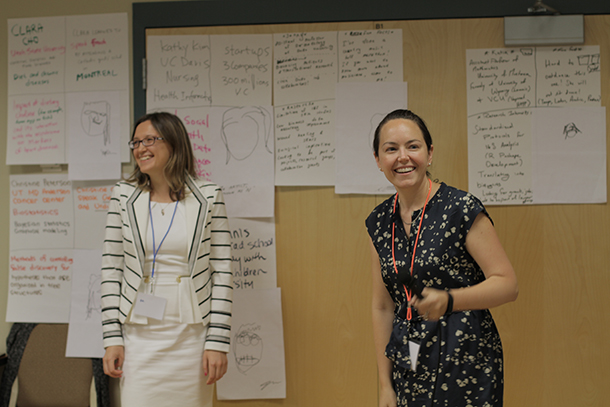Researchers who have attended the Data Science Innovation Lab, a one-week residential training workshop led by members of the USC Mark and Mary Stevens Neuroimaging and Informatics Institute at the Keck School of Medicine of USC, cite the experience as a turning point in their careers. Many have forged key professional connections, obtained funding and published research as a result of the event.
“I left the Lab teeming with ideas and wanting to test them out immediately,” said Jennifer Powers, MD, assistant professor of dermatology at the University of Iowa, who attended the workshop in June 2017. “I am truly thankful for the opportunity to meet mentors, role models and collaborators through this program.”
The Data Science Innovation Lab, which is run by the institute’s Big Data to Knowledge Training Coordinating Center (BD2K TCC) and funded by the National Institutes of Health’s BD2K initiative, is now entering its fourth year. Previous workshops have united mathematicians, statisticians and biomedical researchers to explore topics such as mobile health informatics and big data solutions for studying the human microbiome.
“We’re training the next generation of scientists in data science techniques and technologies,” said Jack Van Horn, PhD, associate professor of neurology and director of education at the USC Stevens Neuroimaging and Informatics Institute. “They need to be prepared early so that they know how to handle the ever-more data we’re going to collect.”
Out of their comfort zone
During the 2017 Innovation Lab, Powers teamed up with several other researchers, including statisticians and bioinformaticians, to create a “Smart Bandage” that can detect microbial changes in a bandage after surgery. The bandage will be designed to detect infection in a surgical wound and is intended to help those with limited health resources. So far, Powers has submitted one grant proposal and is working on a second; she also has contributed to a review article on the microbiome.
“The faculty (mentors) present as navigators and guides served as a constant catalyst for making good connections and finding common ground with other participants,” she said. “By the sheer strategy of their approach, they forced us to get out of our comfort zones and begin learning the languages of other disciplines.”
Nirmish Shah, MD, assistant professor of medicine and pediatrics at the Duke University School of Medicine, attended the Innovation Lab in 2015 and 2016. On his first visit, he collaborated with several other attendees to develop a hybrid mathematical and statistical model for pain, based on mobile app data he had collected. As a direct result of the project, he later received funding from the National Science Foundation and the National Institutes of Health to build hybrid models predicting pain scores. Shah has published multiple papers, including one in Smart Health in February, and recently submitted an R01 grant along with fellow Innovation Lab participants to further explore the use of wearable technology.
“The most valuable progress I’ve made is through the connections at all these different institutions that I made through the Data Science Innovation Lab,” Shah said. “All of my work has pivoted toward this kind of research.”
Building bridges across disciplines
At the Innovation Lab, junior faculty value the opportunity to interface with talented mentors and colleagues across a broad range of disciplines.
“Training the next generation of investigators of course requires that they’re given the best tools and experiences,” said Arthur W. Toga, PhD, Provost Professor of Ophthalmology, Neurology, Psychiatry and the Behavioral Sciences, Radiology and Engineering, Ghada Irani Chair in Neuroscience, and director of the USC Stevens Neuroimaging and Informatics Institute. “But on top of that, cross-disciplinary partnerships are essential to their success.”
This year’s workshop will take place in Bend, Oregon from June 25 to 29. Thirty participants will convene alongside six faculty mentors to explore the mathematical challenges of single cell dynamics. Applications are due by Feb. 28; interested parties can learn more and apply here.
— Zara Abrams


